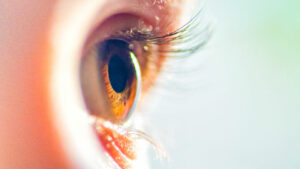September 15, 2023
By Dwight Akerman, OD, MBA, FAAO, FBCLA, FIACLE
 Red light, a short wavelength visible light of 600-700 nm, has been used to treat various diseases, such as promoting cell synthesis, wound healing, hair growth, fracture healing, and regeneration of damaged nerves. In recent years, repeated low-level red light (RLRL) therapy has emerged as a new myopia therapeutic intervention, particularly in China.
Red light, a short wavelength visible light of 600-700 nm, has been used to treat various diseases, such as promoting cell synthesis, wound healing, hair growth, fracture healing, and regeneration of damaged nerves. In recent years, repeated low-level red light (RLRL) therapy has emerged as a new myopia therapeutic intervention, particularly in China.
RLRL can stimulate the production of dopamine, which is crucial for controlling eye growth, along with nitrous oxide (NO), which dilates blood vessels and increases blood flow. However, the exact molecular pathways underlying the action of the method and its influence on choroidal and scleral responses, blood flow regulation, and cellular processes involved in myopia development are still not fully understood.
A recently published meta-analysis demonstrated that RLRL is effective in controlling myopia. Furthermore, the range of power used in previous publications is from 0.35mW to 2.0mW, and the difference in the power of LRL may be an essential factor in the varying results in these studies. However, there is no research to confirm which power of RLRL is most effective in controlling myopia, and there is no consensus regarding the standard power of LRL. An optimal balance between effectiveness and safety of control characterizes the ideal power of RLRL. Consequently, researchers in China aimed to evaluate the efficacy of RLRL for myopia control at powers of 0.37 mW, 0.60 mW, and 1.20 mW.
The study, published in Ophthalmology, enrolled 200 children between the ages of 6 and 15 with myopia ≥-0.50D and astigmatism ≤-2.50D. Participants were randomly assigned to three intervention groups and one control group. Each intervention group wore single-vision spectacles throughout the day and randomly received low-intensity red-light therapy at 0.37mW, 0.60mW, and 1.20mW twice per day for three minutes each session, with at least a four-hour interval. The control group only wore single-vision spectacles throughout the day.
At the end of six months, the progression of SE in the 0.37mW (0.01D), 0.60mW (-0.05D), and 1.20mW (0.16D) groups was significantly lower than in the control group (-0.22D). The changes of axial length in the three groups (0.04mm, 0.00mm, and 0.04 mm, respectively) were significantly smaller than in the control group (0.27mm). Similarly, increases in subfoveal choroidal thickness were significant in the three power level groups (22.63μm, 36.17μm, and 42.59μm, respectively) than in the control group (-5.07μm). No adverse events were observed.
The researchers concluded that different powers of RLRL within a specific range effectively controlled myopia progression in children and did not demonstrate statistical differences. Consequently, selecting a lower power of LRL may be prudent to ensure long-term safety and minimize any possible adverse effects under conditions that guarantee effectiveness.
Abstract
Efficacy of Different Powers of Low-Level Red Light in Children Myopia Control
Wen Zhou, Ya Liao, Wei Wang, Yanmei Sun, Qin Li, Siqi Liu, Jie Tang , Lin Li, Xiaojuan Wang
Purpose: This study aimed to compare the efficacy and safety of low-intensity red light (LRL) in controlling myopia progression across three different powers (0.37 mW, 0.60 mW, and 1.20 mW).
Design: Single-center, single-blind, randomized controlled trial.
Participants: A total of 200 children aged 6 to 15 years with myopia ≥ -0.50 diopter (D) and astigmatism ≤ -2.5 D were enrolled from April to May 2022. Follow-up ended in December 2022.
Methods: Participants were randomly assigned to three intervention groups and one control group (1:1:1:1 ratio). The intervention group wore single-vision spectacle (SVS) throughout the day and were randomly received LRL therapy at 0.37 mW, 0.60 mW and 1.20 mW twice per day for 3 minutes each session, with at least a 4-hour interval. The control group only wore an SVS throughout the day.
Main outcome measures: Changes in spherical equivalent (SE), axial length (AL), and subfoveal choroidal thickness (SFCT) were measured.
Results: At the end of 6 months, the progression of SE in the 0.37 mW [0.01D (95%CI: -0.12, 0.15)], 0.60 mW [(-0.05D (95%CI: -0.18, 0.07)], and 1.20 mW [0.16D (95%CI: 0.03, 0.30)] groups were significantly lower than control group [-0.22D (95%CI: -0.50, 0.30)] (All Padj< 0.001). The changes of AL in the 0.37 mW [0.04mm (95%CI: -0.01, 0.08)], 0.60 mW [0.00mm (95%CI: -0.05, 0.55)], and 1.20 mW [-0.04 mm (95%CI: -0.08, 0.01)] groups were significantly smaller than control group [0.27mm (95%CI: 0.22, 0.33)] (All Padj< 0.001). Similarly, increases in SFCT were significantly in 0.37mW [22.63 μm (95%CI: 12.13, 33.34)], 0.60 mW [36.17 μm (95%CI: 24.37, 48.25)], and 1.20 mW [42.59 μm (95%CI: 23.43, 66.24)] than in the control group [-5.07 μm (95%CI: -10.32, -0.13)] (All Padj< 0.001). No significant differences (SE, AL, or SFCT) at evaluated times for LRL groups, however, a potential trend in figures suggests higher power links to improved efficacy within limits. No adverse events were observed.
Conclusions: LRL effectively controlled myopia progression at 0.37 mW, 0.60 mW, and 1.20 mW. Despite no significant power differences, a trend indicates higher power’s potential effectiveness. More extensive samples and longer follow-ups are vital for optimal LRL power determination.
Zhou, W., Liao, Y., Wang, W., Sun, Y., Li, Q., Liu, S., … & Wang, X. (2023). Efficacy of different powers of Low-level Red Light in Children Myopia Control. Ophthalmology.
DOI: https://doi.org/10.1016/j.ophtha.2023.08.020













